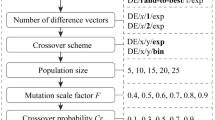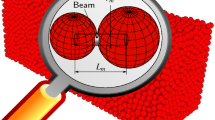Abstract
To solve the complicated macro and micro parameter calibration problem in the discrete element method (DEM) simulation of rock mechanics, macro parameter prediction and micro parameter inversion model are established based on the XGBoost model. Firstly, a parameter database for the uniaxial compressive test in DEM has been established by literature research and numerical simulation. The critical parameters in the uniaxial compressive test have been chosen with data and theoretical analysis. The influence of the number of selected parameters on accuracy has also been discussed. Then, the prediction model and inversion model have been established which can complete the calibration quickly. The two models were tested by test samples, and the accuracy of the model can generally reach more than 90%. This research has great significance for improving the efficiency of discrete element modeling.
Graphical Abstract











Similar content being viewed by others
References
Cundall, P.A.: A computer model for simulating progressive, large-scale movement in blocky rock system. In: Proceedings of the International Symposium on Rock Mechanics, France, 1971 (1971)
Campbell, C.S., Brennen, C.E.: Computer simulation of granular shear flows. J. Fluid Mech. 151, 167–188 (1985)
Cundall, P.A., Strack, O.D.: A discrete numerical model for granular assemblies. Geotechnique 29, 47–65 (1979)
Walton, O.R.: Particle-Dynamics Modeling of Geological Materials. University of California, Davis, Davis (1981)
Bahaaddini, M., Hagan, P.C., Mitra, R., Khosravi, M.H.: Experimental and numerical study of asperity degradation in the direct shear test. Eng. Geol. 204, 41–52 (2016)
Bock, S., Prusek, S.: Numerical study of pressure on dams in a backfilled mining shaft based on PFC3D code. Comput. Geotech. 66, 230–244 (2015)
Haeri, H.: Experimental and numerical study on crack propagation in pre-cracked beam specimens under three-point bending. J. Cent. South Univ. 23, 430–439 (2016)
Khazaei, C., Hazzard, J., Chalaturnyk, R.: Damage quantification of intact rocks using acoustic emission energies recorded during uniaxial compression test and discrete element modeling. Comput. Geotech. 67, 94–102 (2015)
Lin, C.-H., Lin, M.-L.: Evolution of the large landslide induced by Typhoon Morakot: a case study in the Butangbunasi River, southern Taiwan using the discrete element method. Eng. Geol. 197, 172–187 (2015)
Oetomo, J.J., Vincens, E., Dedecker, F., Morel, J.-C.: Modeling the 2D behavior of dry-stone retaining walls by a fully discrete element method. Int. J. Numer. Anal. Met. 40, 1099–1120 (2016)
Oliaei, M., Manafi, E.: Static analysis of interaction between twin-tunnels using discrete element method (DEM). Sci. Iran. 22, 1964 (2015)
Turichshev, A., Hadjigeorgiou, J.: Experimental and numerical investigations into the strength of intact veined rock. Rock Mech. Rock Eng. 48, 1897–1912 (2015)
Wang, Z., Jacobs, F., Ziegler, M.: Experimental and DEM investigation of geogrid–soil interaction under pullout loads. Geotext. Geomembr. 44, 230–246 (2016)
Yang, S.-Q., Tian, W.-L., Huang, Y.-H., Ranjith, P.G., Ju, Y.: An experimental and numerical study on cracking behavior of brittle sandstone containing two non-coplanar fissures under uniaxial compression. Rock Mech. Rock Eng. 49, 1497–1515 (2016)
Zhou, M., Song, E.: A random virtual crack DEM model for creep behavior of rockfill based on the subcritical crack propagation theory. Acta Geotech. 11, 827–847 (2016)
Liao, C.-L., Chan, T.-C.: A generalized constitutive relation for a randomly packed particle assembly. Comput. Geotech. 20, 345–363 (1997). https://doi.org/10.1016/S0266-352X(97)00010-4
Oñate, E., Zárate, F., Miquel, J., Santasusana, M., Celigueta, M.A., Arrufat, F., Gandikota, R., Valiullin, K., Ring, L.: A local constitutive model for the discrete element method. Application to geomaterials and concrete. Comput. Part. Mech. 2, 139–160 (2015). https://doi.org/10.1007/s40571-015-0044-9
Fakhimi, A., Villegas, T.: Application of dimensional analysis in calibration of a discrete element model for rock deformation and fracture. Rock Mech. Rock Eng. 40, 193 (2006). https://doi.org/10.1007/s00603-006-0095-6
Potyondy, D.O., Cundall, P.A.: A bonded-particle model for rock. Int. J. Rock Mech. Min. 41, 1329–1364 (2004). https://doi.org/10.1016/j.ijrmms.2004.09.011
Wang, M., Cao, P.: Calibrating the micromechanical parameters of the PFC2D (3D) models using the improved simulated annealing algorithm. Math. Probl. Eng. 2017, 1–11 (2017). https://doi.org/10.1155/2017/6401835
Guo, J., Xu, G., Jing, H., Kuang, T.: Fast determination of meso-level mechanical parameters of PFC models. Int. J. Rock Mech. Min. 23, 157–162 (2013). https://doi.org/10.1016/j.ijmst.2013.03.007
Yoon, J.: Application of experimental design and optimization to PFC model calibration in uniaxial compression simulation. Int. J. Rock Mech. Min. 44, 871–889 (2007). https://doi.org/10.1016/j.ijrmms.2007.01.004
Deng, S., Zheng, Y., Feng, L., Zhu, P., Ni, Y.: Application of design of experiments in microscopic parameter calibration for hard rocks of PFC3D model. Chin. J. Geotech. Eng. 41, 655–664 (2019)
Xu, H., Dong, W., Hu, B.: Application of DEM Particle Flow Code in Hydraulic and Geotechnical Engineering. Science Press, Beijing (2017)
Cheng, Y., Yang, W., He, D.: Relationship of rock microscopic parameters with the elastic modulus and strength. J. Vibroeng. 21, 901–910 (2019). https://doi.org/10.21595/jve.2018.19849
Wang, Y., Tonon, F.: Calibration of a discrete element model for intact rock up to its peak strength. Int. J. Numer. Anal. Met. 34, 447–469 (2010)
Xiao-tao, Y.I.N., Chun-guang, L.I., Shui-lin, W.: Study on relationship between micro-parameters and macro-parameters of rock and soil material. Chin. J. Solid Mech. 32, 343–351 (2011)
Zou, Q., Lin, B.: Modeling the relationship between macro- and meso-parameters of coal using a combined optimization method. Environ. Earth Sci. 76, 479 (2017). https://doi.org/10.1007/s12665-017-6816-1
Plassiard, J.-P., Belheine, N., Donze, F.-V.: A spherical discrete element model: calibration procedure and incremental response. Granul. Matter 11, 293–306 (2009). https://doi.org/10.1007/s10035-009-0130-x
Fuchs, R., Weinhart, T., Meyer, J., Zhuang, H., Staedler, T., Jiang, X., Luding, S.: Rolling, sliding and torsion of micron-sized silica particles: experimental, numerical and theoretical analysis. Granul. Matter 16, 281–297 (2014). https://doi.org/10.1007/s10035-014-0481-9
Hanley, K.J., O’Sullivan, C., Oliveira, J.C., Cronin, K., Byrne, E.P.: Application of Taguchi methods to DEM calibration of bonded agglomerates. Powder Technol. 210, 230–240 (2011). https://doi.org/10.1016/j.powtec.2011.03.023
Cheng, H., Shuku, T., Thoeni, K., Yamamoto, H.: Probabilistic calibration of discrete element simulations using the sequential quasi-Monte Carlo filter. Granul. Matter 20, 11 (2018). https://doi.org/10.1007/s10035-017-0781-y
Cheng, H., Shuku, T., Thoeni, K., Tempone, P., Luding, S., Magnanimo, V.: An iterative Bayesian filtering framework for fast and automated calibration of DEM models. Comput. Methods Appl. Mech. 350, 268–294 (2019). https://doi.org/10.1016/j.cma.2019.01.027
Tawadrous, A.S., DeGagné, D., Pierce, M., Mas Ivars, D., et al.: Prediction of uniaxial compression PFC3D model micro-properties using artificial neural networks. Int. J. Numer. Anal. Methods Geomech. 33, 1953–1962 (2009). https://doi.org/10.1002/nag.809
Zhou, Y., Wu, S., Jiao, J., Zhang, X.: Research on mesomechanical parameters of rock and soil mass based on BP neural network. Rock Soil. Mech. 32, 3821–3826 (2011)
Sun, M., Tang, H., Hu, X., Ge, Y., Lu, S.: Microparameter prediction for a triaxial compression PFC3D model of rock using full factorial designs and artificial neural networks. Geotech. Geol. Eng. 11, 1249–1259 (2013)
Zhai, S., Zhan, J., Ba, Y., Chen, J., Li, Y., Li, Z.: PFC model parameter calibration using uniform experimental design and a deep learning network. IOP Conf. Ser. Earth Environ. Sci. 304, 032062 (2019). https://doi.org/10.1088/1755-1315/304/3/032062
Ben Turkia, S., Wilke, D.N., Pizette, P., Govender, N., Abriak, N.-E.: Benefits of virtual calibration for discrete element parameter estimation from bulk experiments. Granul. Matter 21, 110 (2019). https://doi.org/10.1007/s10035-019-0962-y
Zeng, D., Yao, J., Huo, J.: Inversion of rock meso-mechanical parameters based on parallel particle swarm optimization (PSO) algorithm. J. Xi’an Shiyou Univ. Nat. Sci. Ed. 30, 27-32+5 (2015)
Cho, N., Martin, C.D., Sego, D.C.: A clumped particle model for rock. Int. J. Rock Mech. Min. 44, 997–1010 (2007). https://doi.org/10.1016/j.ijrmms.2007.02.002
Jiang, M.: New paradigm for modern soil mechanics: geomechanics from micro to macro. Chin. J. Geotech. Eng. 41, 195–254 (2019)
Chen, T., Guestrin, C.: XGBoost: a scalable tree boosting system. In: Proceedings of the 22nd ACM SIGKDD International Conference on Knowledge Discovery and Data Mining, pp. 785–794 (2016). https://doi.org/10.1145/2939672.2939785
Wang, X., Zhang, L., Li, J., Sun, Y., Tian, J., Han, R.: Study on XGBoost improved method based on genetic algorithm and random forest. Comput. Sci. 454–458+463 (2020)
Chen, H., Wang, G., Xiao, C., Guo, P., Huang, J., Chen, H.: Research on intrusion detection model based on DBN-XGBDT. Comput. Eng. Appl. 56, 83–91 (2020)
Xia, L., Zeng, Y., Zhang, S.: Influence of meso-mechanical parameters of bedding plane on strength characteristics of layered rock mass. J. Yangtze River Sci. Res. Inst. 33, 68–75 (2016)
Cui, J., Liang, Q.: Research on the relationship between meso and macroscopic mechanical parameters of rock based on PFC3D model. Bull. Sci. Technol. 35, 8–15 (2019)
Duan, K., Kwok, C.Y., Tham, L.G.: Micromechanical analysis of the failure process of brittle rock: micromechanical analysis brittle rock. Int. J. Numer. Anal. Methods Geomech. 39, 618–634 (2015). https://doi.org/10.1002/nag.2329
Zhang, X.-P., Wong, L.N.Y.: Cracking processes in rock-like material containing a single flaw under uniaxial compression: a numerical study based on parallel bonded-particle model approach. Rock Mech. Rock Eng. 45, 711–737 (2012). https://doi.org/10.1007/s00603-011-0176-z
He, P., Kulatilake, P.H.S.W., Yang, X., Liu, D., He, M.: Detailed comparison of nine intact rock failure criteria using polyaxial intact coal strength data obtained through PFC3D simulations. Acta Geotech. 13, 419–445 (2018). https://doi.org/10.1007/s11440-017-0566-9
Li, Z., Rao, Q.: Quantitative determination of PFC3D microscopic parameters. J. Cent. South Univ. 28, 911–925 (2021). https://doi.org/10.1007/s11771-021-4653-6
Haeri, H., Sarfarazi, V.: PFC3D simulation of the effect of particle size on the single edge-notched rectangle bar in bending test. Struct. Eng. Mech. 68, 497–505 (2018). https://doi.org/10.12989/sem.2018.68.4.497
Ding, X., Zhang, L.: Simulation of rock fracturing using particle flow modeling: phase I—model development and calibration. In: 45th US Rock Mechanics/Geomechanics Symposium. OnePetro (2011)
Fan, X., Kulatilake, P.H.S.W., Chen, X., Cao, P.: Crack initiation stress and strain of jointed rock containing multi-cracks under uniaxial compressive loading: a particle flow code approach. J. Cent. South Univ. 22, 638–645 (2015). https://doi.org/10.1007/s11771-015-2565-z
Yue, K., Olson, J.E., Schultz, R.A.: Calibration of stiffness and strength for layered rocks. In: 50th U.S. Rock Mechanics/Geomechanics Symposium. OnePetro (2016)
Yang, B., Jiao, Y., Lei, S.: A study on the effects of microparameters on macroproperties for specimens created by bonded particles. Eng. Comput. 23, 607–631 (2006)
Acknowledgements
The research was supported by the National Natural Science Foundation of China (51991391, U1806226, 52021005), and the Tang Scholar Program of Shandong University.
Author information
Authors and Affiliations
Corresponding authors
Ethics declarations
Conflict of interest
The authors declare no conflict of interest.
Additional information
Publisher's Note
Springer Nature remains neutral with regard to jurisdictional claims in published maps and institutional affiliations.
Rights and permissions
Springer Nature or its licensor holds exclusive rights to this article under a publishing agreement with the author(s) or other rightsholder(s); author self-archiving of the accepted manuscript version of this article is solely governed by the terms of such publishing agreement and applicable law.
About this article
Cite this article
Zhou, Z., Bai, S., Chu, K. et al. Calibration of DEM macro and micro parameters via XGBoost method. Granular Matter 24, 106 (2022). https://doi.org/10.1007/s10035-022-01264-0
Received:
Accepted:
Published:
DOI: https://doi.org/10.1007/s10035-022-01264-0




